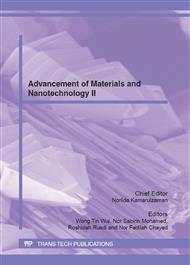p.240
p.247
p.251
p.259
p.264
p.269
p.275
p.279
p.285
Investigation of Ionic Conduction and Morphological Properties of PMMA-Based Polymer Electrolytes Containing Lithium Iodide
Abstract:
In this study, the two systems of polymethylmethacrylate (PMMA) based polymer electrolyte films have been prepared by the solution casting technique. Lithium iodide (LiI) and ethylene carbonate (EC) were used as inorganic salt and plasticizer, respectively. The highest room temperature conductivity for the plasticized system and unplasticized system is 4.42 x 10-5 Scm-1 and 4.37 x 10-6 Scm-1, respectively. The conductivity-temperature dependence studies have been performed on these films in the temperature range of 303 K to 373 K. It can be observed that the log σ versus 1000/T plots obey the Arrhenius rule and VTF rule for the plasticized film and unplasticized film, respectively [1-3]. The surface morphology of the plasticized and unplasticized films was observed by using scanning electron microscope (SEM).
Info:
Periodical:
Pages:
264-268
Citation:
Online since:
July 2012
Keywords:
Price:
Сopyright:
© 2012 Trans Tech Publications Ltd. All Rights Reserved
Share:
Citation:


